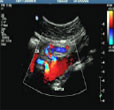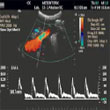AIM:
To examine with ultrasound the arteries that branch off the abdominal aorta to supply blood to the stomach, intestines, colon, liver and spleen. These arteries can become narrowed (stenosed) or abnormally dilated (aneurysm). Narrowing can cause a critical reduction in blood supply to the gut (this can cause pain and in severe cases parts of the gut can die as a result) while aneurysms can burst and bleed if allowed to enlarge. The ultrasound examination employs sound waves to examine the shape of the artery and to study the flow inside the artery (i.e.; 2 types of information and thus the name ‘Duplex’ ultrasound). This information about an artery helps your doctor to make a diagnosis and decide treatment options without using needles or invasive tests. This type of ultrasound can only diagnose and does not treat the arterial problem.
PREPARATION:
The test requires that the subject fasts for 6 to 8 hours beforehand as swallowed food and gas in the gut will obscure the technician’s view of the arteries, which are deep in the abdomen near the spine.
TECHNIQUE:
The subject lies on an examination couch with just the abdomen exposed. The technician applies ultrasound jelly and presses the ultrasound probe on the abdominal wall, angling it in order to direct the sound beam in various directions. The probe detects reflected sound waves after they bounce off various organs in the belly and images are produced on the computer screen. (see examples below)
DURATION:
Approximately 60 minutes
DIAGNOSTIC CRITERIA:
A greater than 70% stenosis of the superior mesenteric artery would be predicted by a SMA peak systolic velocity of > 275 cm/sec. A similar degree of stenosis in the celiac vessel appeared to be predicted by a peak systolic velocity of > 200 cm/sec
Click here to view the worksheet.





